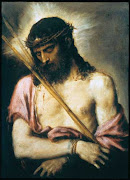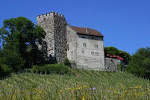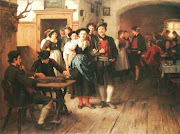I think our dearly beloved Pope should learn the virtue of silence.
The job of the Pope is to defend the faith not to court public
favour by the mouthing of fashionable attitudes.
However, this might perhaps remind us all to pray to St Joseph Pignatelli SJ, the great Jesuit saint at the time of the suppression of the Jesuits by an earlier pope, Clement XIV.
He was a Spanish nobleman, of Neapolitan extraction, and a Jesuit at the time of the Spanish suppression in 1767, and at
the general suppression of the Order, shamefully and shockingly by papal decree, in 1773.
All the Jesuits of Spain were taken to the port of Tarragona and banished from the country, in no less than 13 flotillas of ships. They were refused entry at numerous ports but eventually disembarked at Corsica before finding refuge in Ferrara.
St Joseph remained faithful and steadfast despite being betrayed by the very people from whom he should most have enjoyed support and blessing, not least the Pope.
St Joseph Pignatelli SJ, saviour and restorer of the Jesuit Order after the conflagration of the French Revolution
He continued
ever-faithful, betrayed by all those who should most have protected and
favoured him, not least the Pope.
In his time, the Society of Jesus began to be suppressed in each country of Christendom, first Portugal, then Spain, then France, then even the Holy Roman Empire, then, finally, in 1773, Pope Clement XIV was, himself, prevailed upon by the Freemasonic ministers of Europe to suppress the whole Order, world-wide.
It was a shocking betrayal of the greatest religious Order the world has ever seen.
These same Freemasonic ministers, the Marquess of Pombal in Portugal, the Count of Aranda in Spain, the Duke of Choisel in France and the Prince von Kaunitz in the Empire, had prevailed upon their own Kings to expel the Jesuits from their territories and then, finally, they forced the Pope to do so universally.
A portrait of the fanatically anti-clerical Marquess of Pombal, Prime Minister of Portugal, expelling the Jesuits from Portugal in 1766, the first Freemasonic minister of Christendom to do so from a Catholic country
At that time, Jesuits ran almost all the leading schools and universities throughout Christendom. The gap was then artfully and deceitfully filled by theologically weak and freemasonically-inclined teachers and clerics who sullied the minds of the young with foolish ideas and heterodox theories.
This greatly helped lead to the disaster of the French Revolution.
Meantime, Jesuits from all over the world, the courts of China, Japan and India, the plains of Ethiopia, the jungles of Latin America, the forest of the Philippines and from all corners of the earth, were arrested, chained, imprisoned and then, chained in the holds of ships,
sent to Europe from all over the world and dumped - dead, dying and living - on the shores of
the Papal States.
Yet even the Pope refused to take them in, so afraid was he of the heavy hand of the Freemasons and secret secular societies.
Charles Maucourt. The Expulsion of the Jesuits from Spain. 1767.
Ironically, it was the
anti-Catholic King of Prussia and Empress of Russia that eventually gave the last of the Jesuits
shelter in Silesia and Muscovy.
The remainder were dispersed across Europe to fend for themselves, forming little societies here and there.
St Joseph was forbidden to exercise any priestly ministry at all and so retired to study and pray.
But he lived to see the whole Order restored, effectively saving the Order himself.
Some little known facts about the Jesuit Order:
2. Their dictionaries and lexicons of the native languages in North America in the 17th century were the first resources Europeans used to understand these ancient tongues, and they still provide modern scholars with the earliest transcriptions of the languages.
3. They located the source of the Blue Nile and charted large stretches of the Amazon and Mississippi Rivers.
4. They educated Descartes, Voltaire, Moliere, James Joyce, Peter Paul Rubens, Arthur Conan Doyle, Fidel Castro, Alfred Hitchcock, and Bill Clinton—not to mention Bing Crosby.
5. They founded the city of Sao Paolo, Brazil.
6. There are 35 craters on the moon named for Jesuit scientists. And Athanasius Kircher, a 17th-century Jesuit scientist, called “master of a hundred arts” and “the last man to know everything”, was a geologist, biologist, linguist, decipherer of hieroglyphics, and inventor of the megaphone.
7. They count 40 saints and dozens of beati among their members, including the globe-trotting missionary St Francis Xavier.
[Source: James Martin, SJ, The Jesuit Guide to Almost Everything]
The modern film, The Mission, starring Jeremy Irons and Robert de Niro, tells something of the story of the suppression and expulsion of the Jesuits from the Reductions in Paraguay in Latin America, where they had taught the Indians to make violins and to write and sing great religious choral masterpieces in a quasi-Baroque style with unique Indian styles.
Here is an extract from the film:
St Joseph was earlier appointed Jesuit Provincial of Italy, saw a restoration in Naples, the restoration of the Gesu to and the Roman College to the Order by Pius VII in 1811.
Finally St Joseph directed the Order before its official restoration world-wide in 1815, the year of Waterloo and the Congress of Vienna, but he did not live to see it, dying of TB in 1811.
He was canonised in 1954.
With the suppression of the Jesuits, St Joseph Pignatelli saw the whole Catholic world collapse around him. He showed saintly and remarkable leadership in dark and difficult times and was a tower of quiet strength to many during those
troubled times, so like our own.
St Joseph Pignatelli, pray for us!








.jpg)

















_-002.jpg/220px-Circle_of_Anton_Raphael_Mengs,_Henry_Benedict_Maria_Clement_Stuart,_Cardinal_York_(ca_1750)_-002.jpg)

